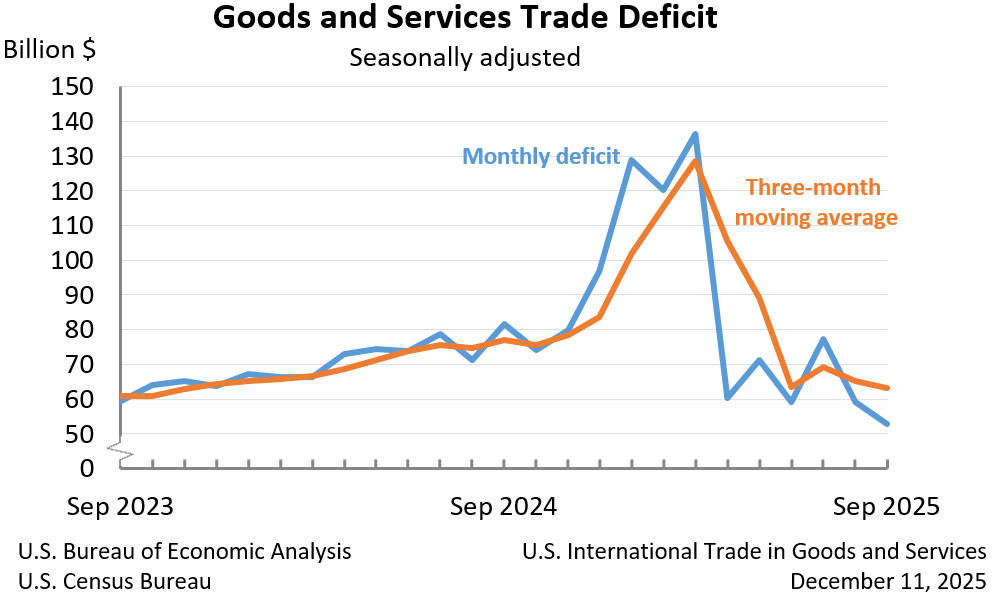Bureau of Economic Analysis
U.S. International Trade in Goods and Services, September 2025
The U.S. goods and services trade deficit decreased in September 2025 according to the U.S. Bureau of Economic Analysis and the U.S. Census Bureau. The deficit decreased from $59.3 billion in August (revised) to $52.8 billion in September, as exports increased more than imports. The goods deficit decreased $7.1 billion in September to $79.0 billion. The services surplus decreased $0.6 billion in September to $26.2 billion.
Principal Federal Economic Indicators
Noteworthy
The Latest
New Foreign Direct Investment in the United States, 2018
Expenditures by foreign direct investors to acquire, establish, or expand U.S. businesses totaled $296.4 billion in 2018, up 8.7 percent from $272.8 billion in 2017.
Spending on Durable Goods Increases in May
Personal income increased 0.5 percent in May, the same increase as in April. Wages and salaries, the largest component of personal income, increased 0.2 percent in May after increasing 0.3 percent in April.
Personal Income and Outlays, May 2019
Personal income increased 0.5 percent in May, the same increase as in April. Wages and salaries, the largest component of personal income, increased 0.2 percent in May after increasing 0.3 percent in April.
GDP Increases in First Quarter
Real gross domestic product (GDP) increased 3.1 percent in the first quarter of 2019, according to the “third” estimate released by the Bureau of Economic Analysis. The growth rate was unrevised from the “second” estimate released in May. In the fourth quarter of 2018, real GDP rose 2.2 percent.
Gross Domestic Product, First Quarter 2019 (Third Estimate); Corporate Profits, First Quarter 2019 (Revised Estimate)
Real gross domestic product (GDP) increased at an annual rate of 3.1 percent in the first quarter of 2019 (table 1), according to the "third" estimate released by the Bureau of Economic Analysis. In the fourth quarter of 2018, real GDP increased 2.2 percent. Profits from current production (corporate profits with inventory valuation and capital consumption adjustments) decreased $59.3 billion in the first quarter, compared with a…
U.S. Net International Investment Position – First Quarter 2019
The U.S. net international investment position decreased to –$9.93 trillion (preliminary) at the end of the first quarter of 2019 from –$9.55 trillion (revised) at the end of the fourth quarter of 2018. The $374.4 billion decrease reflected net financial transactions of –$30.2 billion and net other changes in position, such as price and exchange-rate changes, of –$344.2 billion.
U.S. Net International Investment Position: First Quarter 2019, Year 2018, and Annual Update
The U.S. net international investment position decreased to -$9.93 trillion (preliminary) at the end of the first quarter of 2019 from -$9.55 trillion (revised) at the end of the fourth quarter of 2018, according to statistics released by the Bureau of Economic Analysis (BEA).
State Personal Income, First Quarter 2019
State personal income increased 3.4 percent at an annual rate in the first quarter of 2019, a deceleration from the 4.1 percent increase in the fourth quarter of 2018. Personal income increased in all states except South Dakota. The percent change in personal income across all states ranged from 5.6 percent in West Virginia to -0.6 percent in South Dakota.
State Personal Income, First Quarter 2019
State personal income increased 3.4 percent at an annual rate in the first quarter of 2019, a deceleration from the 4.1 percent increase in the fourth quarter of 2018. Personal income increased in all states except South Dakota. The percent change in personal income across all states ranged from 5.6 percent in West Virginia to -0.6 percent in South Dakota.
U.S. Current-Account Deficit Decreases in First Quarter 2019
The U.S. current-account deficit decreased to $130.4 billion (preliminary) in the first quarter of 2019 from $143.9 billion (revised) in the fourth quarter of 2018. As a percentage of U.S. gross domestic product, the deficit decreased to 2.5 percent from 2.8 percent. The previously published current-account deficit for the fourth quarter was $134.4 billion.




